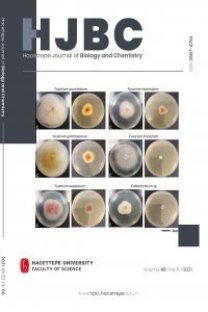Toprak Kökenli Bazı Trichoderma Türlerinin Moleküler Karakterizasyonu
Trichoderma, moleküler karakterizasyon, toprak
Molecular Characterization of Some Soil Originated Trichoderma Species
Trichoderma, molecular characterization, soil,
___
- 1. L. Atanosova, S. Le Crom, F.Coulpier, V.SeidlSeiboth, C.P. Kubicek, I.S.Druzhinina, Comparative transcriptomics reveals different strategies of Trichoderma mycoparasitism, BMS Genomics, 22 (2013) 121-134.
- 2. L. Hojos-Carvajal, J. Bissett, Biodiversity of Trichoderma in Neotropics, The Dynamical Processes of Biodiversity-case studies of evolution and spatial distribution, (2011), Oscar Grillo (Ed.). ISBN:9780953- 307-772-7.
- 3. A. Schuster, M. Schmoll, Biology and biotechnology of Trichoderma, Appl Microbiol Biotechnol., 87 (2010) 787-799.
- 4. I.S. Druzhinina, V. Seidl-Seiboth, A. Herrera-Estrella, B.A. Horwitz, C.M. Kenerley, E. Monte, P.K. Mukherjee, S. Zeilinger, I.V. Grigoriev, C.P. Kubicek, Trichoderma: the genomics of opportunistic success, Nat. Rev. Microbiol., 16 (2011) 749-759.
- 5. I.S. Druzhinina, C.P. Kubicek, M. Komon-Zelalowska, T. Belayneh Mulaw, J. Bissett, The Trichoderma harzianum demon: complex speciation history resulting in coexistence of hypothetical biological species, recent agamospecies and numerous relict lineages, BMC Evolutionary Biol., 10 (2010) 2-14.
- 6. C.P. Kubicek, M. Komon-Zelazowska, I.S. Druzhinina, Fungal genus Hypocrea/Trichoderma: from barcodes to biodiversity, J. Zhejiang Univ. Sci. B., 9 (2008) 753- 763.
- 7. L. Kredics, S. Naeimi, L. Manczinger, I.S. Druzhinina, Biodiversity of the genus Hypocrea/Trichoderma in different habitats In: Biotechnology and Biology of Trichoderma, Ed. By: Gupta et al., ed, (2014) Elsevier, B.V.
- 8. G.J. Samuels, S. Dodd, B.S. Lu, The Trichoderma koningii aggregate species, Stud. Mycol., 56 (2006) 67-133.
- 9. I.S.Druzhinina, A.G. Kopchinsky, C.P. Kubicek, The first 100 Trichoderma species characterized by molecular data, Mycoscience, 47 (2006) 55-64.
- 10. P. Chaverri, F. Branco-Rocha, W. Jaklitsch, R. Gazis, T. Degenkolb, G.J. Samuels, Systematics of the Trichoderma harzianum species complex and the reidentification of commercial biocontrol strains, 107 (2015) 140-147.
- 11. L. Hojos-Carvajal, S. Orduz, J. Bissett, Genetic and metabolic biodiversity of Trichoderma from Colombia and adjacent neotropic regions, Fungal Genet. Biol., 46 (2009) 615-631.
- 12. F. Mirkhani, H. Alseei, Species diversity of indigenous Trichoderma from alakaline pistachio soils in Iran, Mycologia Iranica, 2 (2015) 22-37.
- 13. M.H. Aydın, G. Turhan, The presence of Trichoderma and Gliocladium species in various features of soil in Turkey, Conference paper, Symposium on EurAsian Biodiversity, (2016) Antalya, Turkey.
- 14. B.N. Chakraborty, U. Chakraborty, A. Saha, P.L. Dey, K. Sunar, Molecular characterization of Trichoderma viride and Trichoderma harzianum isolated from soils of North Bengal based on rDNA markers and analysis of their PCR-RAPD profiles, Global Journal of Biotechnology and Biochemistry. 5 (2010) 55-61.
- 15. N.D. Kutluk Yılmaz, B. Tunalı, Evaluation of Trichoderma spp. from central and northern regions of Turkey for supression of Polymyxa betae as a vector of rhizomaina disease, Arch. O Phyopathol. Plant Prot., 43 (2010), 1534-1542.
- 16. Ç. Küçük, M. Kıvanç, Isolation of Trichoderma spp. and determination of their antifungal, biochemical and phsiological features, Turk J. Biol., 27 (2003) 247-253.
- 17. Q. Migheli, V. Balmas, M. Komoz-Zelalowska, B. Schem, R. Caria, A. Kopchinsky, C.P. Kubicek, I.S. Druzhinina, Soils of a Mediterrranean hotspot of bioviersity and endemism (Sardinia, Tyrrhenian Islands) are inhabited by pan-European and likely invasive species of Hypocrea/Trichoderma, Environ. Microbiol., 11 (2009) 35-46.
- 18. W.M. Jacklitch, H. Voglmayr, Biodiversity of Trichoderma in Southern Europe and Macaronesia (Hypocreaceae), Stud. Mycol., 126 (2015) 143-156.
- ISSN: 2687-475X
- Yayın Aralığı: 4
- Başlangıç: 1972
- Yayıncı: Hacettepe Üniversitesi, Fen Fakültesi
Bazı Tekstil Boyar Maddelerinin Trametes versicolor ile Sulu Çözeltilerden Renginin Giderimi
Özgecan ERDEM, Nilüfer CİHANGİR
Filiz TEZCAN, Sesil UZAŞÇI, Güler UYAR, Zeynep KALAYCIOĞLU, F. Bedia ERİM
Su Örneklerinde Toplam Demir Tayini için Spektrofotometrik Akış Enjeksiyon Yöntemi Geliştirilmesi
Toprak Kökenli Bazı Trichoderma Türlerinin Moleküler Karakterizasyonu
Beytepe Kampüsü Ormanlık Alanının Kene (Acari: Ixodida) Faunası
Saf ve Hileli Ballar Arasında Fiziksel ve Biyokimyasal Özelliklerin Karşılaştırılması
Sevgi KOLAYLI, Oktay YILDIZ, Havvanur GÜNEY, Zehra CAN
Emrah YERLİKAYA, Hasan KARAGECİLİ, Ramazan DEMİRDAĞ, Mustafa Oguzhan KAYA
Elif KARACAOĞLU, Güldeniz SELMANOĞLU
